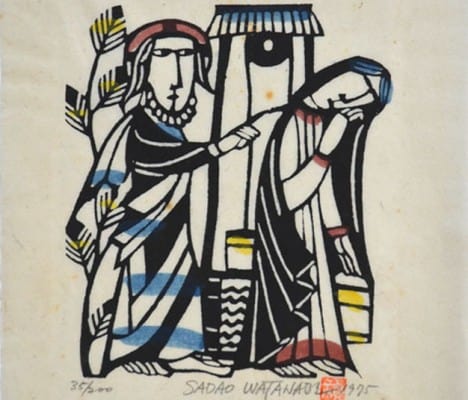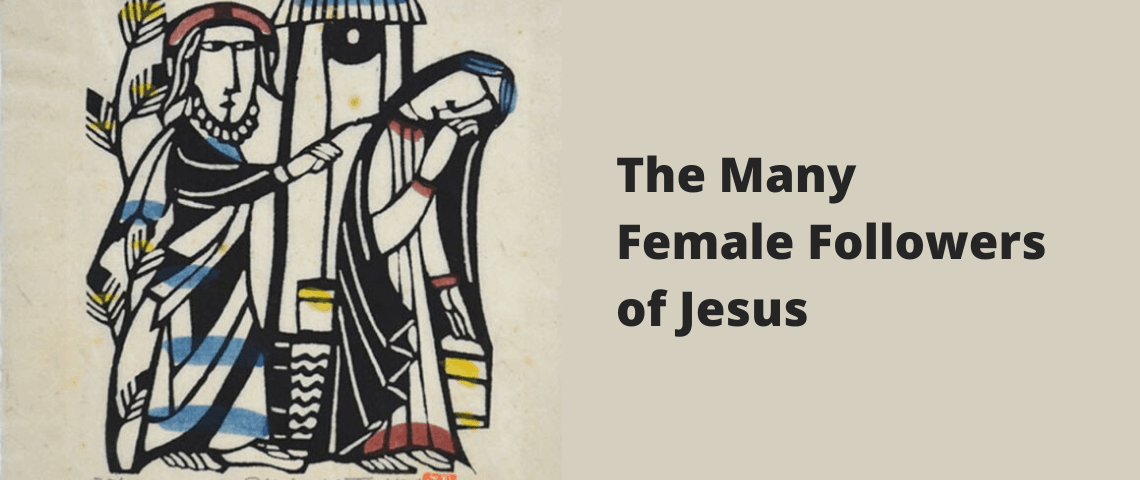
Jesus had many female followers.
I read Matthew 27:55-56 recently and saw something I had not noticed before. There were many female followers at Jesus’ crucifixion – many. I had previously imagined that only a few women had accompanied Jesus and made the trip all the way from Galilee to Jerusalem – usually a journey of several days.
NEAR THE CROSS
These women had travelled to be with Jesus and to minister to him by taking care of his needs. From this group of many, Matthew identified just three of the women: Mary Magdalene, Mary the mother of James and Joseph, and the unnamed mother of the sons of Zebedee. Mark, in his parallel account, also lists just three women: Mary Magdalene, Mary the mother of James and Joseph, and Salome[1], but he adds that many other women from Galilee were near the cross with them (Mark 15:40-41 cf Mark 16:1).
TOWN TO TOWN
Luke speaks of certain women who had accompanied Jesus during his itinerant teaching and healing ministry. In Luke 8:1-3, he wrote that women travelled with Jesus and provided for him out of their own resources. Like Matthew and Mark, Luke identified just three of the women: Mary Magdalene, Joanna the wife of Chuza, and Susanna, but adds (in verse 3) that there were many other women in this group.
Many women were dedicated followers of Jesus during his ministry on earth. Many of these women seem to have been independent of fathers and husbands, and some were independently wealthy. These women left the relative comfort of their homes and travelled in rough conditions to faithfully follow and serve their Lord. There is little doubt that Jesus welcomed these women and valued their ministry.
FRIENDS AND FOLLOWERS
Jesus did not shy away from female company. He had several, perhaps even many, close female friends, women such as Mary Magdalene, Joanna, Martha and Mary of Bethany, etc. And he continually showed kindness and respect to the many other women he encountered during his ministry.
I’ve often pictured Jesus roaming around Galilee with just the Twelve, but on several occasions, at the very least, there were many women with him also. How many is many? 10, 20, 30, 40, or more? Did the women disciples outnumber the men? We can only speculate as to how many women were among Jesus’ followers. (Cf Acts 1:13-14.)
One thing is certain: throughout the last two millenia many more women have continued to follow Jesus and serve him. And Jesus continues to welcome their company and value their ministry.
YOUR TURN: When did you first realize that Jesus had many women followers? How has that impacted your faith journey?
Read more about women disciples in these posts: Were the Disciples Unschooled, Ordinary Men? and The Life and Times of Mrs. Zebedee.
A note about the artist: When Gail’s parents served as missionaries in Japan they discovered the work of Sadao Watanabe (1913-1996), who converted from Buddhism to Christianity at 17 years old. He expressed his faith through traditional Japanese stencil dying (katazome), saying ‘My task is to stand within the artistic tradition of Japan…Theology will not take deep root in Japanese soil if it is merely an import.” Read more in this post by Makoto Fujimura.
This article was first published at newlife.id.au.




22 responses to “The Many Female Followers of Jesus”
My husband has been ministering about this exact same truth at our Church and at our Youth. Thank you Marg. love your posts.
Marg
Much the same goes for Paul’s female colleagues – I’d taken the women he mentions in Romans 16 and elsewhere for ‘ordinary’ if dedicated Christians – now I see they were his fellow-workers and house-church leaders.
Yes, Paul uses the same descriptions (or terminology) for his many female coworkers as he does for his many male coworkers.
And, in Romans 16, two women top the list of people mentioned by Paul: Phoebe is first and Priscilla is second. Eight more women are mentioned in the chapter.
Paul valued his female ministry colleagues.
Powerful observation, Marg, thanks so much. Since I first became a Christian I noticed those other women but many times we live in a kind of disconnect between what we’re taught, and what we observe for ourselves, and it’s great when such articles jog the disconnect out of place. Jesus was totally up for women among HIs followers.
Bev, I lived in this ‘disconnect’ you aptly describe until I went to a bible college a few years ago as a mature Masters student (initial degree in literature). I’d never heard this point brought out at church. I am still amazed and rejoicing at how many women there actually are!
I reckon many people think they can count up biblical women on the fingers of one hand – Ruth, Esther, Hannah and a couple of Marys. (well, I barely exaggerate…)
The fingers of the other hand are for the ‘bad women’ of course – Miriam ‘the leper’ (I once heard a sermon in this vein), Bathsheba, Rahab, a couple of ‘Jezebels’… (one for each Testament).
Then there’s that ‘exception’, Deborah’… seeing as we don’t want to count her, the best thing is to negate her…
It’s wonderful that things are changing!
I love all of you here. 🙂
Me too! The readers of TJP are lovely and smart.
Such gracious and insightful comments. 🙂
Ah, thanks, Cindy! We are so blessed by our readers and the way they encourage and challenge us. And thanks for your advocacy for women as well.
Marg, I’ve noticed the number of women who surround Jesus too. Traveling with him, spending their money on him, feeding him, anointing him, standing by him as he hangs on the cross, being in front of the open tomb looking for him. Lots and lots of women in lots and lots of places with our Lord.
Absolutely. Lots and lots . . . and this is still happening.
I agree with Mark Neale, there may be many more women than men in the resurrection. I heard a preacher say he did not know why but the bible did not speak of the women. That led me to seek out the bible and see for myself. There are many accounts of women in the bible some named and others not ,whom were faithful followers of Jesus. Need to say I not only switched churches this also led me from Baptist to Methodist.
Considering the pervasive patriarchal culture of the time, it is amazing how many women are mentioned in both the Old and New Testaments, and many of their stories include significant or heroic acts.
I heard a male preacher speak on the birth of Samson once without ever mentioning Samson’s mother who is the main character in Judges 13. This blindness continues, but hopefully to a lesser degree than before, now that we have women scholars, teachers, writers, and preachers, etc.
I suspect that at the resurrection the women will out number the men, and white folk will be the minority. Great post.
You could well be right. I think we are all going to get a big surprise at the resurrection.
May I ask u and Mark why u think this? Have my own theories, but would like to hear yours first. First time poster.
Hi Margaret, generally speaking, I think many western Christians hold to different values and/or priorities concerning church life and ministry than what we see demonstrated and taught in the New Testament. So we may be surprised by the humble being exalted and the last being first, or, in other words, the unnoticed “nobodies” being acknowledged as important in the kingdom.
Furthermore, I think many western evangelicals will be surprised by the resurrection itself. Many churches barely mention our bodily resurrection from death which is our future and our hope.
Thanks, Marg, for highlighting the women who followed Jesus. After translating the Gospel of Matthew in seminary and helping to preach through our church’s series on Luke’s Gospel, I can’t help but think the gospel writers became “Jesus feminists” and activists through their pens by spotlighting the women who would have normally been kept in the shadows by their culture.
One thing I’ve noticed in my NA27 Greek NT is that even though the Greek text uses the word pollai (“many”) to describe the women disciples, the English titles say “some women” (e.g. Luke 8:1-3). I’m perplexed by these misleading titles.
Several passages in Luke certainly seem to be designed to promote male-female equality.
Great post–thanks Marg. One of the things I find fascinating is it states that the women accompanied Jesus from Galilee on his final journey which ended in the crucifixion. Jesus left for Jerusalem in Luke 9. The women were therefore with him for many important events.
For sure. And they were at the empty tomb, and were among the first witness of Jesus’ resurrection which (according to what Paul may be saying in 1 Cor. 9:1) qualifies them as apostles.
SInce the Galilean women were used to travel, I see nothing to indicate that they didn’t keep travelling with the message of the Gospel after Pentecost.